In 1855 Auvers-sur-Oise was a picturesque large village in the heart of the department of Seine-et-Oise (78) to the north of Paris. With its surrounding hamlets, stretched out along the Oise valley, its north bank lay at the foot of the Vexin plateau, where vast fields stretched to the edge of the horizon.
The population of Auvers was about two thousand and it was a busy administrative center, not lacking in tradesmen and artisans. Paris was only 22 miles away and could be reached in a little less than an hour by train. In fact, since 1846, there had been a regular service of about twelve trains a days to the capital.
The local council had just had the main road to Pontoise resurfaced in stone and it was here that a master mason built a house for himself, not far from the Colombières manor house. The mason was Auguste Crosnier, a native of the village. He had just married a seamstress called Adélaïde Caffin. The young couple’s resources were no doubt modest for Crosnier salvaged as many building materials as he could for his new home, right down to using whole sections of a wall from an 18th-century building.
Auguste Crosnier had chosen a very convenient site. A few years later the village Mairie (town hall) was built immediately opposite, with its white walls, slate roof and bell tower. The council building was also to be the site of the primary school with accommodation for the schoolmaster. Alongside it was the Post Office, which already boasted a telegraph. The little square quickly grew to be a very lively place. There were soon shops selling the latest items available in Paris. Thursday was the day of the weekly cattle market, an especially lively time, when peasants and livestock breeders met to do business.
What could be more natural than for someone to open a café right here, in the very heart of the village? In 1876 Crosnier’s daughter Valentine and her husband Alfred Levert (although she was still under age) began running a wine business from the house.
Levert was the son of an Auvers man who combined the professions of cabaret owner and surveyor and he knew how to make a business thrive.
In 1884 he remodeled the front of the building, had a glazed shop front installed and an elegantly-painted sign put up. The new “Café de la Mairie” attracted customers and became a good gathering place for artists.
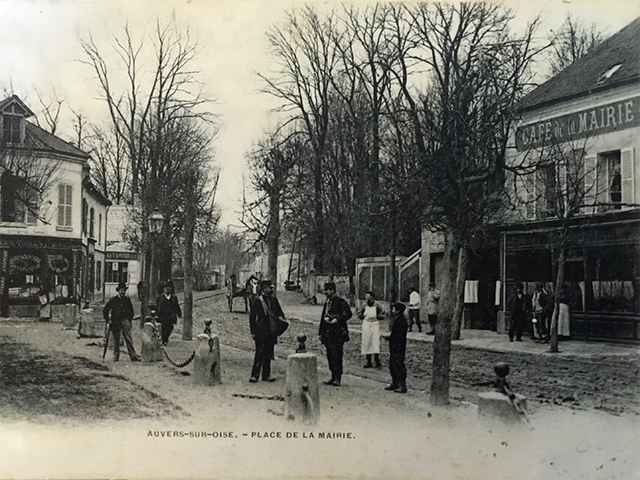 This was the time when young painters travelled to Auvers by train to seek advice and guidance from the masters of Impressionism: Camille Pissarro lived nearby in Pontoise and Honoré Daumier was in the neighboring village of Valmondois. Charles-François Daubigny was in Auvers itself, and Paul Cézanne had worked here for two years.
Outside market days, the clientele consisted largely of artisans, carpenters, masons, blacksmiths, workingmen from the surrounding villages and agricultural journeymen. Just like most other Auvers inns and cafés, Levert’s place had a couple of furnished rooms where travelling salesmen, artists and city folk on holiday could be accommodated.
This was the time when young painters travelled to Auvers by train to seek advice and guidance from the masters of Impressionism: Camille Pissarro lived nearby in Pontoise and Honoré Daumier was in the neighboring village of Valmondois. Charles-François Daubigny was in Auvers itself, and Paul Cézanne had worked here for two years.
Outside market days, the clientele consisted largely of artisans, carpenters, masons, blacksmiths, workingmen from the surrounding villages and agricultural journeymen. Just like most other Auvers inns and cafés, Levert’s place had a couple of furnished rooms where travelling salesmen, artists and city folk on holiday could be accommodated.
In 1889, M. and Mme Levert began to look for an innkeeper to run the business for them. They came to an agreement with a certain M. Ravoux who took out a lease on the Inn and soon the establishment inherited his name.
Arthur Gustave Ravoux was born in Paris in 1848 and had worked his way through several trades before coming to Auvers: butcher and laundryman in Rueil, then pork butcher and poulterer in Aubervilliers, before settling in nearby Menucourt in the Seine- et- Oise Department…
With his portly build, round cheeks and bushy moustache, he looked like a man who lived well. He had a natural look of friendliness and his round spectacles, high forehead and receding hairline gave the new innkeeper a look of respectability. It was said that he was good company and people welcomed his advice.
Yet he would fly into a rage if anyone contradicted him, which happened more than once when his tales of the Franco-Prussian War of 1870 went on too long for his customers’ liking.
Arthur Ravoux had all his family with him: his young wife Louise, a pretty brunette who dressed attractively; then there was his elder daughter Adeline, just thirteen, and baby Germaine, one year old.
Ravoux’s premises were furnished differently from the Parisian brasseries of the time; there were stout wooden tables and country-style chairs with wicker seats. The main room was spacious with a tiled floor and walls painted in the deepest-red, their plainness broken only by a leaf-shaped stencil whose pattern was repeated in a toning border that circled the room. One wall was livened up by a large fresco of a country scene.
Two glazed doors were set into the shop front. The narrower one on the left opened into the wine merchant’s, the wider one on the right into the restaurant. To the side of the building was a passage; iron rings had been fixed into the wall for customers to tie up their horses and carts. Beyond these was the back door.
Inside, aniseed or absinth-based apéritifs were served, but they were not drunk anything like as much as wine. At the end of the 19th century, wine was considered part of the staple diet, as important as bread, and drunk from the break of dawn to well after sundown.
In the Ravoux Inn, just as in the guinguettes (the dancing-and-music establishments) along the banks of the Oise and the Seine so often painted by Charles Daubigny, Auguste Renoir and Claude Monet, little local wines served chilled were popular, such as those of Argenteuil or a ginglet from the slopes of the Oise. Their quality was uneven but at least they were not suspected of being trafficked, like the cheap wines to be found in Paris. Wines from Burgundy and Beaujolais were brought up by train and also drunk with pleasure.
As days drew to a close, Ravoux would walk around his zinc-topped counter to light the oil lamps for customers gathering around what had pride of place at the Inn – the billiard table. In winter months a chunky iron stove would purr soothingly away in the café whilst in warmer times customers preferred the open air and would linger at iron tables in front of the Inn, under the shade of the trees that lined the street.
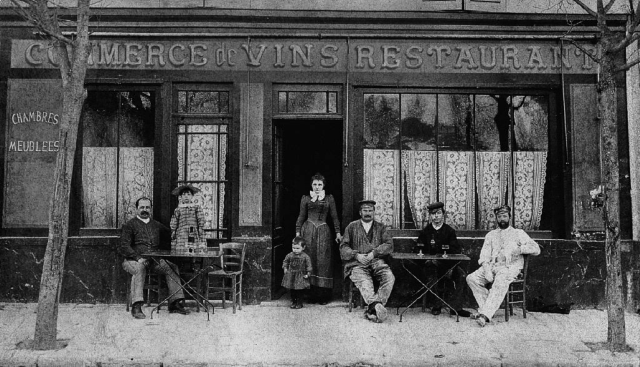 This is just how Ravoux had a picture of himself taken in 1890.
His daughter Adeline described the back room of the Inn as being “completely given over to the artists” who lodged there and who could sometimes be seen finishing their paintings inside.
This is just how Ravoux had a picture of himself taken in 1890.
His daughter Adeline described the back room of the Inn as being “completely given over to the artists” who lodged there and who could sometimes be seen finishing their paintings inside.
The lodgers all had their own keys to the back door at the end of the side alley. To get to their rooms they had to climb the narrow staircase dimly lit by a small oval-shaped window.
There were four rooms on the first floor and three on the second, alongside the attic. The rooms were furnished in only a rudimentary way: a bed, a chair, a little bedside cabinet, or a cupboard for keeping one’s things in. To wash, people had just a jug of water and a bowl. Running water in Auvers was available only at the village pump (since 1883 thanks to the Compagnie Générale des Eaux). Ravoux had to pump his own from the well in the yard behind the Inn.
On May 20th 1890, a train coming from Paris pulled into the Auvers station. A Dutch painter could be made out amongst the little crowd making its way along the platform. Van Gogh intended to stay in Auvers for a while, and to visit a Doctor by the name of Gachet who had been recommended to Theo van Gogh by Camille Pissarro.
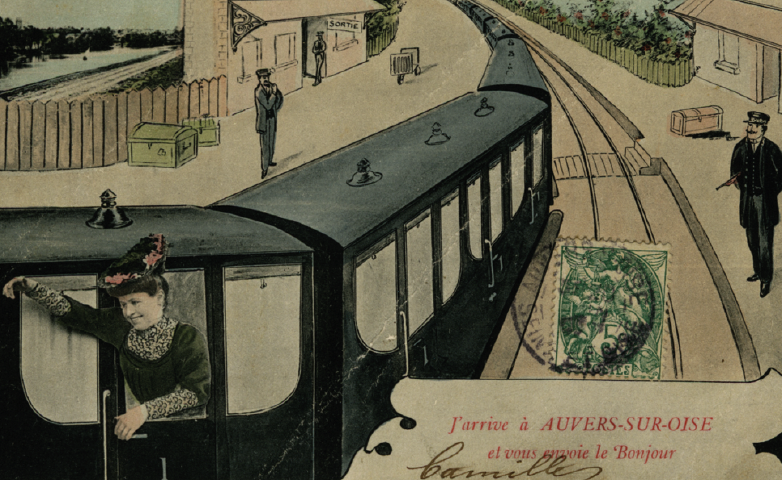 Ravoux had the little room on the second-floor landing available, lit by a skylight let into the roof. It cost only 1 franc per day, and meals would be 2.50 francs on top. The Inn was only one of ten or so in Auvers at the time, of which the more comfortable offered bed and board for 6 francs, and there were cheaper ones too. Yet the Inn was quaint and well-kept, so Vincent van Gogh – with an eye to his budget no doubt – decided to stay in the Ravoux Inn ‘temporarily’. Later, when his furniture arrived from Arles, he would be able to find a studio in the village.
Ravoux had the little room on the second-floor landing available, lit by a skylight let into the roof. It cost only 1 franc per day, and meals would be 2.50 francs on top. The Inn was only one of ten or so in Auvers at the time, of which the more comfortable offered bed and board for 6 francs, and there were cheaper ones too. Yet the Inn was quaint and well-kept, so Vincent van Gogh – with an eye to his budget no doubt – decided to stay in the Ravoux Inn ‘temporarily’. Later, when his furniture arrived from Arles, he would be able to find a studio in the village.
That very same springtime another Dutch painter, Anton Hirschig, moved into an adjacent room on the second floor. It was possibly Theo van Gogh who had given him Vincent’s address. He was young and had a lively character and seemed to paint more for fun than with conviction. Although he was improving all the time, as Vincent noted, he has left hardly a trace in the annals of art history.
“Monsieur Vincent”, as the Ravoux family called Van Gogh, soon became a familiar figure at the Inn. He seemed happy with his modest bed and board and came over as well behaved, sober and friendly. Yet he lived only for his painting. Every morning he would set out with all his equipment, ready to paint in the village or the surrounding fields. Once back at the Inn he took up his pen to write long letters. Although not one to mix, he enjoyed playing in the evening with baby Germaine, drawing things for her on a slate until the sandman arrived and she started to nod off.
The Ravoux family was almost certainly unaware of Vincent’s visits to Dr Gachet. As newcomers to the village themselves they had hardly enough time to make the acquaintance of the doctor, who did not practice in the village anyway. They might just have been surprised the day the doctor turned up at the Inn to look at Vincent’s canvases…
It looked as though Vincent was happy at the Inn; he was even hoping his brother Theo would come and bring his family there for the holidays. The Auvers countryside was so much closer than Holland and nicer than Paris! Vincent was inclined to agree with the Ravoux family, who felt that his young nephew would thrive better in the countryside, where the air was healthier than in the city. Vincent urged his brother to come, but the plan was not to materialize. The early summer was sultry, with thunderstorms, but at the Ravoux Inn life seemed to be as peaceful as ever.
On Sunday 6th July Vincent arrived back at the Inn very tense and weary after a day in Paris with his brother Theo. No one could have suspected the tragedy to be enacted here just a few weeks later. Arthur Ravoux had other things on his mind than the morale of his lodgers. He was more concerned about Alfred Levert’s decision to sell the Inn. A local landowner bought the property. It was a Mr. Delépine of Butry (which was still part of Auvers at the time). The sale went through on 8th July 1890; fortunately for Ravoux none of this affected the smooth running of his business.
On the afternoon of 27th July, Vincent set out for the fields as usual, only to return with a serious bullet wound in his chest. He had shot himself in the wheatfields behind the park of the Château of Léry.
Despite his wound, he staggered back to the Inn.
Without saying a word he went past the landlord and his family, who were still at the dinner table, and went up to his room. Some time later, Ravoux became alarmed to hear the unmistakable sounds of groaning coming from upstairs. He ran up to the second floor and found Vincent lying critically injured on his bed. Dr. Gachet and the local practitioner were both called out on emergency. They did what they could, but Dr Gachet had not much hope. Operating there and then was out of the question and transporting the victim to the hospital in Pontoise would only have worsened his condition, given the bumpy ride it would have entailed. So Vincent lay on his bed, smoking his pipe – a concession made by Dr. Gachet despite the seriousness of the injury.
Watch was kept over the dying man in the hot stuffy room just under the roof. Anton Hirschig spent some time at the bedside and exchanged a few words with him. Then he retired to bed in his room next door. All night long the sound of Vincent’s groaning filtered through the thin wall that separated them.
We can imagine Ravoux’s distress and also embarrassment at having to notify Vincent’s next-of-kin and, because the gun-shot wound would certainly prove fatal, at having to inform the Gendarmerie as well. The Gendarmes began their investigation the following morning. Sergeant Rigaumont questioning Vincent in a gruff voice, tried to find out why he had attempted suicide. Vincent was weak but still lucid and admitted that he had shot himself; then he would say no more and refused to answer any more of Rigaumont’s questions. The latter had to leave none the wiser.
By this time, Theo had received the message from Dr. Gachet let for him by Hirschig at the Boussod & Valadon gallery. Theo left immediately and arrived at the Inn around midday. The two brothers spent their last, long evening together deep in conversation. Theo hoped against hope that his brother would pull through. But Vincent’s view was: “Sadness goes on forever”.
 Vincent died at one-thirty that night. He was aged just 37 and had been painting for a mere ten years.
In the morning, Arthur Ravoux went with Theo to the Mairie to deal with the official registration of the death.
By the time Vincent’s close friend the painter Emile Bernard arrived in Auvers the following day, the coffin had already been closed and placed on the billiard table. Vincent’s last canvases had been arranged all around, making what Bernard described as a “sort of halo” in homage to his dead friend. On 30th July a slow procession made its poignant way up the winding lane towards the wheat fields and the little cemetery. Amongst the mourners were Theo, Arthur Ravoux and Dr. Gachet. Alongside them were the painters Emile Bernard, Charles Laval, Lauzet and Lucien Pissarro as well as a few friends such as Père Tanguy, who had been Vincent’s paint merchant, and André Bonger, the brother of Theo’s wife Johanna.
The coffin was carried on a hearse lent by the priest of the neighboring village of Méry-sur-Oise, for Abbé Tessier of Auvers had refused to let his carriage be used to carry a suicide victim.
Vincent died at one-thirty that night. He was aged just 37 and had been painting for a mere ten years.
In the morning, Arthur Ravoux went with Theo to the Mairie to deal with the official registration of the death.
By the time Vincent’s close friend the painter Emile Bernard arrived in Auvers the following day, the coffin had already been closed and placed on the billiard table. Vincent’s last canvases had been arranged all around, making what Bernard described as a “sort of halo” in homage to his dead friend. On 30th July a slow procession made its poignant way up the winding lane towards the wheat fields and the little cemetery. Amongst the mourners were Theo, Arthur Ravoux and Dr. Gachet. Alongside them were the painters Emile Bernard, Charles Laval, Lauzet and Lucien Pissarro as well as a few friends such as Père Tanguy, who had been Vincent’s paint merchant, and André Bonger, the brother of Theo’s wife Johanna.
The coffin was carried on a hearse lent by the priest of the neighboring village of Méry-sur-Oise, for Abbé Tessier of Auvers had refused to let his carriage be used to carry a suicide victim.
After the burial, a grief-stricken Theo suggested to Vincent’s friends that they could keep a painting or two to remember him by. Those that Dr. Gachet chose are the main items in the Gachet collection donated to the Musée du Louvre by Gachet’s son and daughter. Today they can be seen at the Musée d’Orsay in Paris.
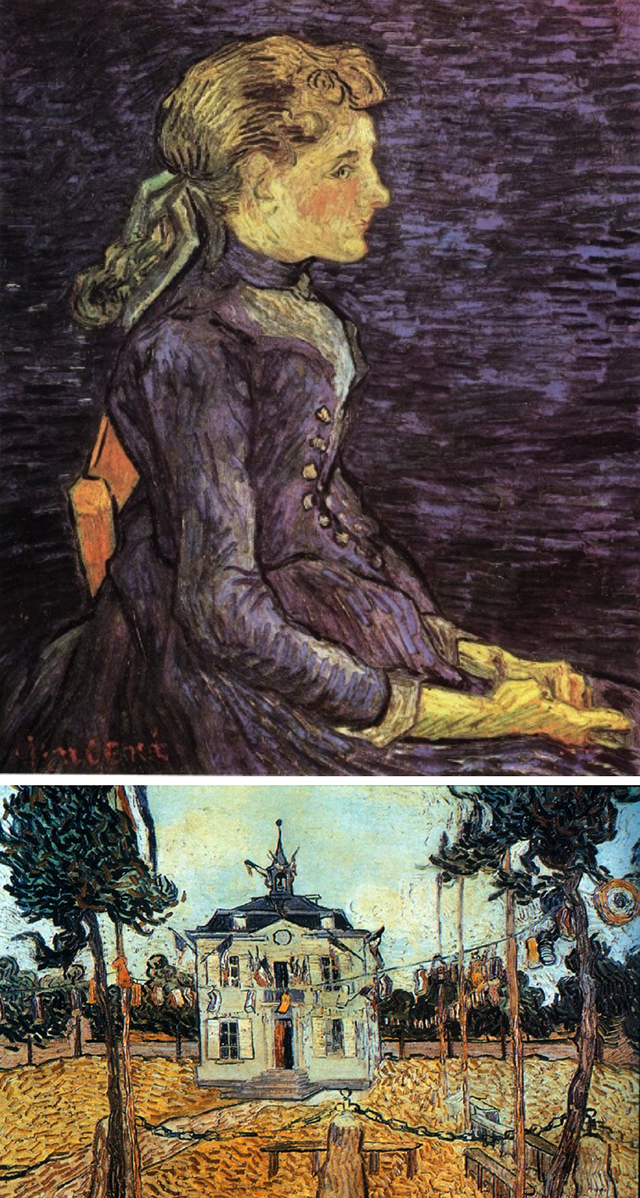 However, Arthur Ravoux would not take anything other than the two paintings that Vincent had painted at the Inn and already given him: the view of the Mairie on Bastille Day, and the famous portrait of his daughter Adeline in blue. Many years later, when he was living in Meulan, he was approached by a group of painters who said they were familiar with Van Gogh’s work, and he accepted their offer – 40 francs.
The time had come to bid a last farewell to everyone. Theo packed the rest of his brother’s belongings and took leave of the Ravoux family. He gave a last gift to baby Germaine as a token of all her parents had done. He then left for Paris, never to return to Auvers alive. Six months later, Theo died in Holland. His body was brought back to Auvers in 1914, when his widow Johanna had him reburied at his brother’s side.
At the Inn the chagrin was soon overtaken by a happy event, for in June 1892 another daughter, Olga Réjanne, was born to the Ravoux family. Then, eight months later, they left the village altogether to run a big brasserie in Meulan. The subsequent innkeeper was called Leleu. Gas lights were installed in the streets of Auvers in 1894. At long last, in 1902, the telephone arrived. There were only five telephones, one in the Post Office itself and the others in the homes of four families of note.
However, Arthur Ravoux would not take anything other than the two paintings that Vincent had painted at the Inn and already given him: the view of the Mairie on Bastille Day, and the famous portrait of his daughter Adeline in blue. Many years later, when he was living in Meulan, he was approached by a group of painters who said they were familiar with Van Gogh’s work, and he accepted their offer – 40 francs.
The time had come to bid a last farewell to everyone. Theo packed the rest of his brother’s belongings and took leave of the Ravoux family. He gave a last gift to baby Germaine as a token of all her parents had done. He then left for Paris, never to return to Auvers alive. Six months later, Theo died in Holland. His body was brought back to Auvers in 1914, when his widow Johanna had him reburied at his brother’s side.
At the Inn the chagrin was soon overtaken by a happy event, for in June 1892 another daughter, Olga Réjanne, was born to the Ravoux family. Then, eight months later, they left the village altogether to run a big brasserie in Meulan. The subsequent innkeeper was called Leleu. Gas lights were installed in the streets of Auvers in 1894. At long last, in 1902, the telephone arrived. There were only five telephones, one in the Post Office itself and the others in the homes of four families of note.
At the beginning of the 20thcentury the shop frontage was modernized and the one that Van Gogh had known disappeared. The former “Commerce de vins et restaurant” remained the village café – a place to get together over a drink, a game of cards, or just a chat.
But war was looming, and at the same time strong new currents of artistic and intellectual life signaled the end of the golden age of painting in Auvers. Artists were beginning to gather in cafés in a place called Montparnasse…
Between the two World Wars, however, a new sort of cultural pioneer came on the scene: Van Gogh’s work was already attracting art historians and photographers, or just enthusiastic members of the general public. The café changed owners and name again: A Van Gogh was the name chosen by the Blot family and it was now possible to visit Vincent’s room.
The Ravoux Inn could have gone the way of many other cafés in the course of time and lost its soul, and after the Liberation of France in 1945 it did indeed change hands several times in a few years. The building was in a poor state of repair and the establishment’s reputation suffered. Even the commemorative plaque on the façade commemorating Vincent’s brief stay did nothing to make up for the now drab and soulless interior.
Fortunately, in 1952 Roger and Micheline Tagliana took over. It was very hard-going at the beginning, but their sheer warmth and enthusiasm made up for being short of funds and the Ravoux Inn once again began to know something of its former convivial atmosphere.
.
Adeline Ravoux came back to visit her former home in 1954, and it was with her help that Vincent’s room was put back together as it had been. It was soon getting regular visits from his devotees.
Thanks also to a group of local painters who met there, the Inn’s traditional role as an artists’ café was revived. The film director Vincente Minnelli was moved by the authenticity of the site and shot Lust for Life on location there, with Kirk Douglas in the role of Vincent. Local people still have vivid memories of the experience.
Intellectuals like André Malraux also began to enjoy the lively atmosphere that prevailed in the ‘House of Van Gogh’, as did artists such as Zadkine, Poliakoff and Pignon. Exhibitions were organized, including a retrospective of the work of Emile Bernard in 1960. And this was where the composer Iannis Xenakis even created one of his works.
When, after 35 years in her kitchen, the widowed Madame Tagliana decided to take a well-earned retirement, she began looking for a buyer for her Inn, which had been listed as a historical monument since 1985.
Local authorities were not interested, but several other offers came in – from businessmen, collectors and large companies. They all wanted to own the House of Van Gogh.
Uppermost in the minds of Madame Micheline Tagliana and her daughter Régine was the essential need to preserve the soul of the Inn. They put their trust in the restoration project and cultural activities proposed by D.C. Janssens. These were based on maintaining the dual role of the Inn as an artists’ café and cultural center. In October 1986 Micheline Tagliana, surrounded by all her friends, bade farewell to the House of Van Gogh.
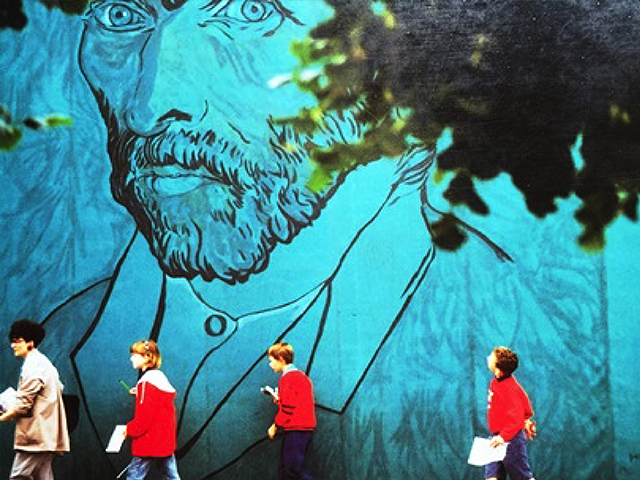 At the change of ownership in 1987 the Ravoux Inn was protected from the elements by an all-enveloping tarpaulin on which was reproduced Vincent’s last self-portrait.
The building was more than 100 years old and in need of complete restoration. It took several years of planning before work at last began in January 1992. The whole building, from the cellar to the rooftops, every part of the structure including the walls, floors and ceilings had to be scanned, tested and reinforced.
Archives were meticulously consulted; layers of plaster and paint examined, and chemical analyses were all painstakingly undertaken with the aim of finding out exactly how the Inn originally looked, right down to the colour scheme. No detail was too small in the quest to resurrect the soul of the House of Van Gogh, while at the same time ensuring optimum conditions for a new generation of customers. It was a complex operation, entrusted to Bernard Schoebel, laureate (1st) of the Grand Prix de Rome, Head Architect of the Public Buildings and National Palaces of France.
The painstaking building works called for a highly-skilled and dedicated team of craftsmen. And so both the very latest conservation techniques and the traditional expertise of the Compagnons du Devoir were called upon to revive all the charm of the Ravoux Inn.
At the change of ownership in 1987 the Ravoux Inn was protected from the elements by an all-enveloping tarpaulin on which was reproduced Vincent’s last self-portrait.
The building was more than 100 years old and in need of complete restoration. It took several years of planning before work at last began in January 1992. The whole building, from the cellar to the rooftops, every part of the structure including the walls, floors and ceilings had to be scanned, tested and reinforced.
Archives were meticulously consulted; layers of plaster and paint examined, and chemical analyses were all painstakingly undertaken with the aim of finding out exactly how the Inn originally looked, right down to the colour scheme. No detail was too small in the quest to resurrect the soul of the House of Van Gogh, while at the same time ensuring optimum conditions for a new generation of customers. It was a complex operation, entrusted to Bernard Schoebel, laureate (1st) of the Grand Prix de Rome, Head Architect of the Public Buildings and National Palaces of France.
The painstaking building works called for a highly-skilled and dedicated team of craftsmen. And so both the very latest conservation techniques and the traditional expertise of the Compagnons du Devoir were called upon to revive all the charm of the Ravoux Inn.
After a year and eight months of building work, the Ravoux Inn has been opening its doors since 17 September 1993 to all devotees of Vincent van Gogh. The restoration has ensured the conservation of a unique historic monument, the only one of Van Gogh’s 37 successive homes to be exactly as it was a century and a quarter ago.
 But this is just the first stage of a long-term cultural project aimed at making Van Gogh’s last dream come true. On 10th June 1890 he confided in a letter to his brother Theo: “Some day or other, I believe I will find a way of having an exhibition of my own in a café.”
But this is just the first stage of a long-term cultural project aimed at making Van Gogh’s last dream come true. On 10th June 1890 he confided in a letter to his brother Theo: “Some day or other, I believe I will find a way of having an exhibition of my own in a café.”
2024 Season:
From 1 March to 24 November
From Wednesday to Sunday:
From 12 p.m. to 6 p.m . (last order 5.30 p.m)
Book a table
Book a table